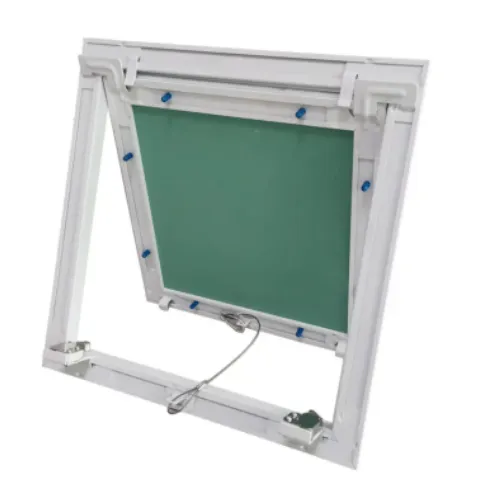Dec . 11, 2024 04:55 Back to list
Access Panel Solutions for Plaster Ceiling Installation and Maintenance Needs
Access Panels for Plaster Ceiling A Comprehensive Guide
In modern construction and renovation, access panels play a vital role in maintaining the aesthetics of a room while providing convenience for maintenance and repair. Specifically, plaster ceiling access panels are designed to seamlessly blend into the ceiling, allowing access to important utilities such as plumbing, electrical wiring, and HVAC systems without disrupting the overall design of the room. This article explores the importance, types, installation process, and maintenance tips for plaster ceiling access panels.
Importance of Access Panels
Access panels are crucial in homes and commercial buildings for several reasons. First and foremost, they provide a discreet solution for accessing plumbing, electrical connections, and ductwork that might otherwise require tearing down portions of the ceiling. This not only saves time but also reduces repair costs associated with damage done to ceilings when access points are not installed.
Additionally, access panels help maintain the aesthetic appeal of plaster ceilings. Traditional designs often require extensive renovations to access hidden utilities, but with the use of an access panel, home and business owners can keep their ceilings looking pristine. They are designed to be flush with the surface, making them nearly invisible to the casual observer.
Types of Plaster Ceiling Access Panels
There are several types of access panels available on the market, catering to various needs and preferences
1. Standard Access Panels These are typically rectangular or square panels that can be installed in ceilings. They are made from various materials, and the frame often supports a plaster finish, allowing for seamless integration.
2. Fire-Rated Access Panels In areas where fire safety is a concern, fire-rated access panels provide the necessary protection. They are constructed with materials resistant to high temperatures and are tested to withstand fire for specific periods, ensuring safety without compromising access.
3. Acoustic Access Panels For places requiring sound insulation, acoustic access panels help minimize sound transmission while still allowing easy access to utilities. They are ideal for offices, conference rooms, and other spaces where noise reduction is important.
4. Customizable Access Panels If standard sizes do not fit the specific needs of a project, customizable access panels are available. Homeowners and builders can request panels that match dimensions, styles, and finishes for a personalized touch.
Installation Process
plaster ceiling access panel

Installing a plaster ceiling access panel is a straightforward process that can be completed by a DIY enthusiast or a professional contractor. Here’s a brief overview of the installation steps
1. Determine the Location Careful planning is essential. Identify where the access panel will be installed, ensuring it allows easy access to the utilities without obstructing the view or flow of the room.
2. Measure and Cut Use a stud finder to locate ceiling joists. Once you have determined the appropriate location, measure and mark a cutout for the access panel. Use a saw to cut along the marked lines carefully.
3. Install the Frame Most access panels come with a frame that needs to be installed first. Secure it into place using screws, ensuring it’s level and flush with the ceiling.
4. Attach the Panel Finally, attach the access panel to the frame. Many panels are designed with spring-loaded mechanisms or simple hinges for easy opening.
5. Finish the Surface Once installed, tape and plaster around the edges, then finish with matching paint or texture.
Maintenance Tips
Once installed, plaster ceiling access panels require minimal maintenance. However, periodic checks are advisable. Here are some tips to keep them in good condition
- Regularly Inspect Check the panel for any signs of wear or damage. Ensure that the hinges and mechanisms work correctly.
- Keep Them Clean Dust and debris can accumulate over time. Regularly clean the surface with a soft, damp cloth.
- Check Seals If the panel is in an area exposed to moisture, ensure seals are intact to prevent water damage.
In conclusion, plaster ceiling access panels are an invaluable addition to any home or commercial space. They enhance accessibility to essential systems while maintaining an elegant, seamless look. Choosing the right type, following proper installation procedures, and performing regular maintenance can significantly extend the life of these functional components. Whether you are undertaking a new construction project or renovating an existing space, consider incorporating plaster ceiling access panels to strike the perfect balance between practicality and aesthetics.
-
Durable Ceiling T Grid Systems | Easy InstallationNewsAug.29,2025
-
PVC Gypsum Ceiling: Durable, Laminated Tiles for Modern SpacesNewsAug.28,2025
-
Pvc Gypsum Ceiling Is DurableNewsAug.21,2025
-
Mineral Fiber Board Is DurableNewsAug.21,2025
-
Ceiling Tile Clip Reusable DesignNewsAug.21,2025
-
Ceiling T Grid Modular DesignNewsAug.21,2025







